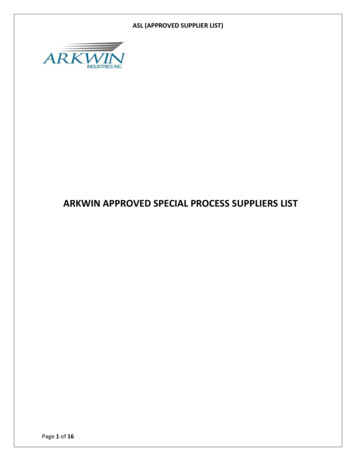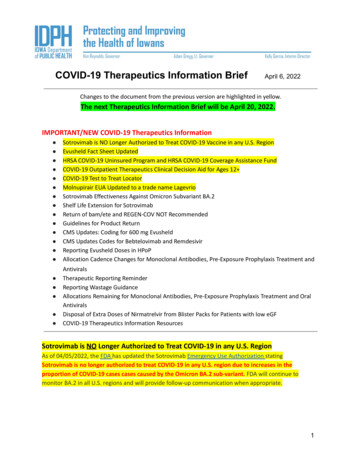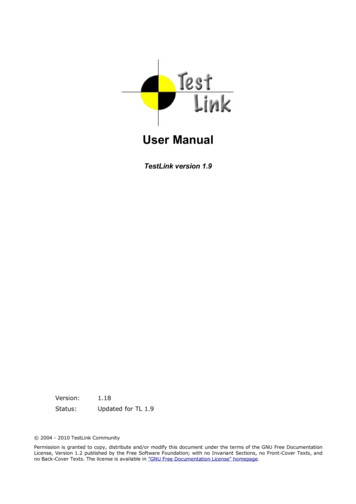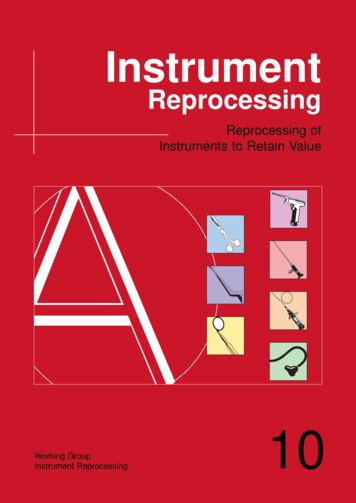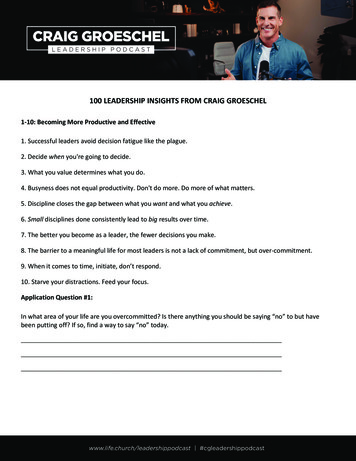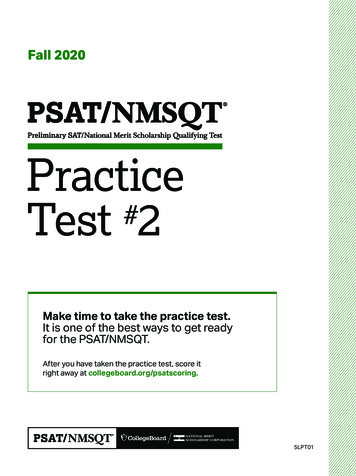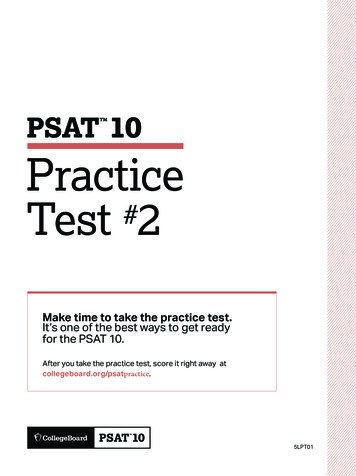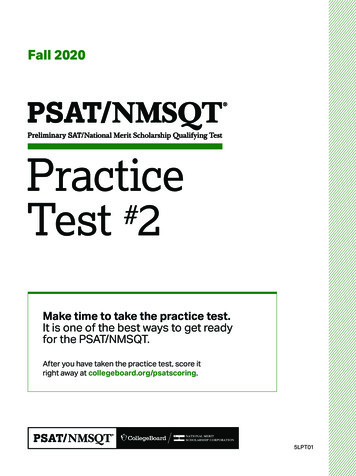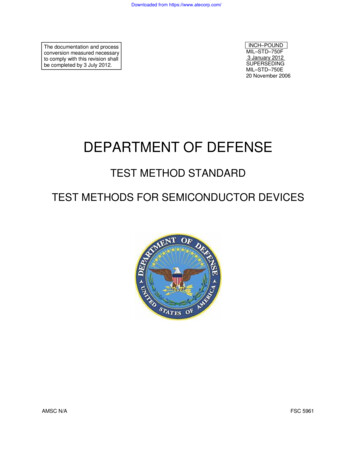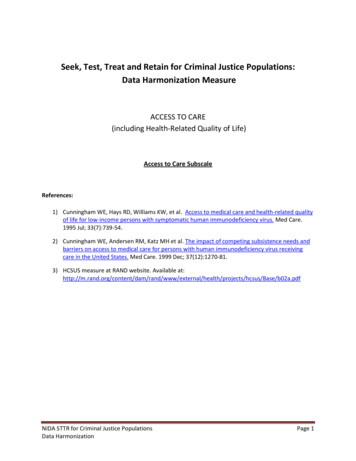
Transcription
Seek, Test, Treat and Retain for Criminal Justice Populations:Data Harmonization MeasureACCESS TO CARE(including Health-Related Quality of Life)Access to Care SubscaleReferences:1) Cunningham WE, Hays RD, Williams KW, et al. Access to medical care and health-related qualityof life for low-income persons with symptomatic human immunodeficiency virus. Med Care.1995 Jul; 33(7):739-54.2) Cunningham WE, Andersen RM, Katz MH et al. The impact of competing subsistence needs andbarriers on access to medical care for persons with human immunodeficiency virus receivingcare in the United States. Med Care. 1999 Dec; 37(12):1270-81.3) HCSUS measure at RAND website. Available /health/projects/hcsus/Base/b02a.pdfNIDA STTR for Criminal Justice PopulationsData HarmonizationPage 1
A. Access to Care ScaleI am going to read you some statements. Please tell me if you strongly agree, somewhat agree, areuncertain, somewhat disagree, or strongly disagree with each statement.(Circle one)Would you agreeStronglyDisagree1If I need hospital care, I can get admittedwithout any trouble.123452It is hard for me to get medical care in anemergency.123453Sometimes I go without the medical care Ineed because it is too expensive.123454I have easy access to the medical specialiststhat I need.123455Places where I can get medical care are veryconveniently located.123456I am able to get medical care whenever Ineed it.12345NIDA STTR for Criminal Justice PopulationsData HarmonizationPage 2
Seek, Test, Treat and Retain for Vulnerable Populations:Data Harmonization MeasureACCESS TO CARE(including Health-Related Quality of Life)Social Support SubscaleReferences:1) Hays RD, Cunningham WE, Beck CK et al (1995). Health-related Quality of Life in HIV Disease.Assessment 2(4): 363-380.2)Berry SH et al (2002). l3) Fleishman JA, Sherbourne CD, Crystal S, et al. Coping, conflictual social interactions, socialsupport, and mood among HIV-infected persons. HCSUS Consortium. Am J Community Psychol.2000 Aug; 28(4):421-53.NIDA STTR for Criminal Justice PopulationsData HarmonizationPage 3
B. Social Support ScalePeople sometimes look to others for companionship, assistance, or other types of support. How oftenwas each of the following kinds of support available to you (during the past 4 weeks) if you needed it?(Circle one)How often do you have:Noneof thetimeA littleof thetimeSomeof thetimeMostof thetimeAllof thetime1Someone to love and make you feel wanted?123452Someone to help with daily chores if you weresick?123453Someone to help you buy medicines?123454Someone to help with transportation?123455Someone to give you money if you needed it?12345NIDA STTR for Criminal Justice PopulationsData HarmonizationPage 4
Seek, Test, Treat and Retain for Vulnerable Populations:Data Harmonization MeasureACCESS TO CARE(including Health-Related Quality of Life)RAND 36-Item Health Survey (Version 1.0)References:1) Hays, R. D., Sherbourne, C. D., and Mazel, R. M. (1993).The rand 36-item health survey 1.0.Health Economics, 2: 217–227. doi: 10.1002/hec.47300203052) Ware, J.E., Jr. and Sherbourne, C.D. (1992). The MOS 36-item short-form health survey (SF-36): I.Conceptual framework and item selection. Medical Care, 30: 473-483.3) Hays, R.D. and Shapiro, M.F. (1992). An overview of generic health-related quality of lifemeasures for HIV research. Quality of Life Research, 1: 91-97.4) Stewart, A.L., Sherbourne, C., Hays, R.D., et al. (1992). “Summary and discussion of MOSmeasures,” In A.L. Stewart and J.E. Ware (Eds.), Measuring functioning and well-being: TheMedical Outcomes Study approach (pp. 345-371). Duke University Press: Durham, NC.For scoring instructions, go to:http://www.rand.org/health/surveys tools/mos/mos core 36item scoring.html.NIDA STTR for Criminal Justice PopulationsData HarmonizationPage 5
D. RAND 36-Item Short Form Survey Instrument1. In general, would you say your health is:Excellent1Very good2Good3Fair4Poor52. Compared to one year ago, how would you rate your health in general now?Much better now than one year ago1Somewhat better now than one year ago2About the same3Somewhat worse now than one year ago4Much worse now than one year ago5The following items are about activities you might do during a typical day. Does your health nowlimit you in these activities? If so, how much?(Circle One Number on Each Line)Yes, Limiteda LotYes, Limiteda LittleNo, Notlimited at All3. Vigorous activities, such as running, lifting heavyobjects, participating in strenuous sports[1][2][3]4. Moderate activities, such as moving a table, pushinga vacuum cleaner, bowling, or playing golf[1][2][3]5. Lifting or carrying groceries[1][2][3]6. Climbing several flights of stairs[1][2][3]7. Climbing one flight of stairs[1][2][3]8. Bending, kneeling, or stooping[1][2][3]9. Walking more than a mile[1][2][3]10. Walking several blocks[1][2][3]11. Walking one block[1][2][3]12. Bathing or dressing yourself[1][2][3]NIDA STTR for Criminal Justice PopulationsData HarmonizationPage 6
During the past 4 weeks, have you had any of the following problems with your work or otherregular daily activities as a result of your physical health?(Circle One Number on Each Line)Yes No13. Cut down the amount of time you spent on work or other activities1014. Accomplished less than you would like1015. Were limited in the kind of work or other activities1016. Had difficulty performing the work or other activities (for example, it took extra effort)10During the past 4 weeks, have you had any of the following problems with your work or otherregular daily activities as a result of any emotional problems (such as feeling depressed oranxious)?(Circle One Number on Each Line)Yes No17. Cut down the amount of time you spent on work or other activities1018. Accomplished less than you would like1019. Didn't do work or other activities as carefully as usual1020. During the past 4 weeks, to what extent has your physical health or emotional problemsinterfered with your normal social activities with family, friends, neighbors, or groups?(Circle One Number)Not at all 1Slightly 2Moderately 3Quite a bit 4Extremely 5NIDA STTR for Criminal Justice PopulationsData HarmonizationPage 7
21. How much bodily pain have you had during the past 4 weeks?(Circle One Number)None 1Very mild 2Mild 3Moderate 4Severe 5Very severe 622. During the past 4 weeks, how much did pain interfere with your normal work (including bothwork outside the home and housework)?(Circle One Number)Not at all 1A little bit 2Moderately 3Quite a bit 4Extremely 5These questions are about how you feel and how things have been with you during the past 4weeks. For each question, please give the one answer that comes closest to the way you have beenfeeling.How much of the time during the past 4 weeks . . .(Circle One Number on Each Line)All oftheTimeMost of A Good Bitthe Time of the TimeSome ofthe TimeA Little ofthe TimeNone ofthe Time23. Did you feel full of pep?12345624. Have you been a very nervousperson?12345625. Have you felt so down in thedumps that nothing could cheeryou up?12345626. Have you felt calm andpeaceful?12345627. Did you have a lot of energy?12345628. Have you felt downhearted andblue?123456NIDA STTR for Criminal Justice PopulationsData HarmonizationPage 8
29. Did you feel worn out?12345630. Have you been a happyperson?12345631. Did you feel tired?12345632. During the past 4 weeks, how much of the time has your physical health or emotionalproblems interfered with your social activities (like visiting with friends, relatives, etc.)?(Circle One Number)All of the time 1Most of the time 2Some of the time 3A little of the time 4None of the time 5How TRUE or FALSE is each of the following statements for you.(Circle One Number on Each efinitelyFalse33. I seem to get sick a little easierthan other people1234534. I am as healthy as anybody I know1234535. I expect my health to get worse1234536. My health is excellent12345NIDA STTR for Criminal Justice PopulationsData HarmonizationPage 9
D. RAND 36-Item Short Form Survey Instrument 1. In general, would you say your health is: Excellent 1 Very good 2 Good 3 Fair 4 Poor 5 2. Compared to one year ago, how would you rate your health in general now? Much better now than one year ago 1 Somewhat better now than one year ago 2 About the same 3 Somewhat worse now than one year ago 4
